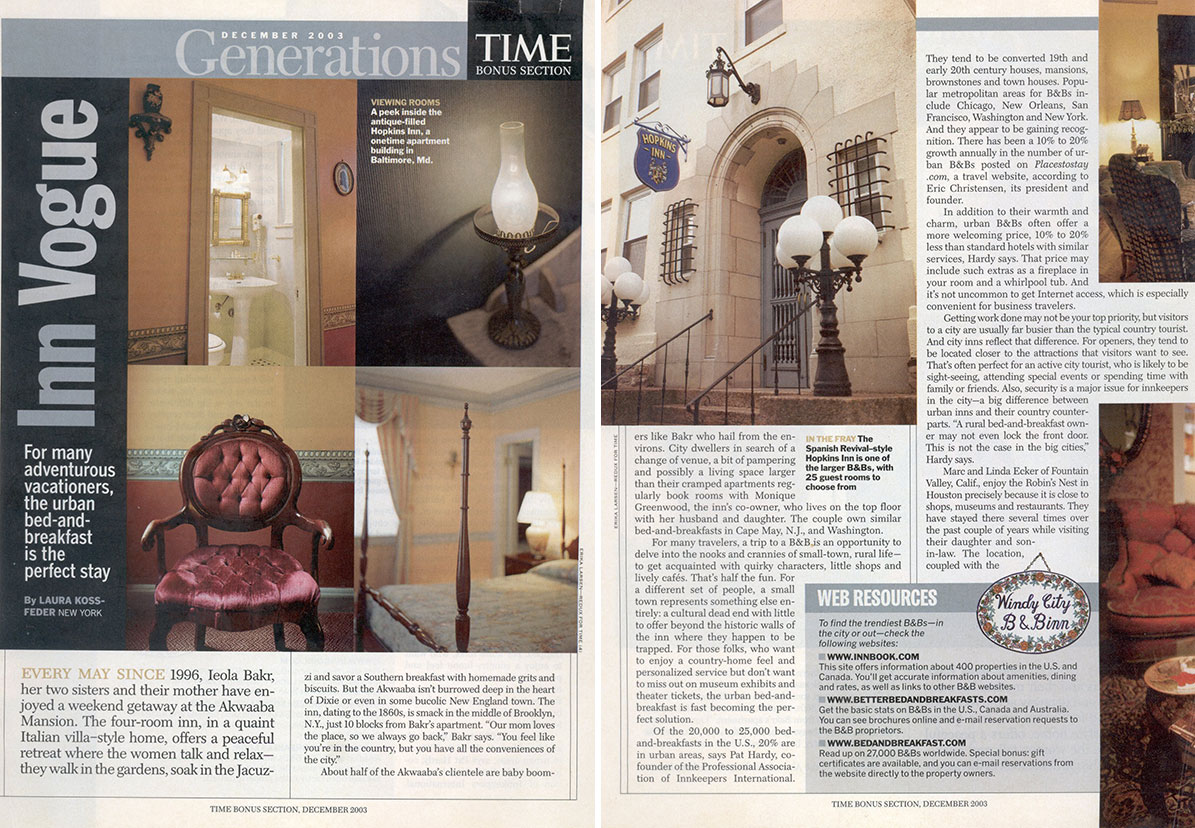Project Description
Time Magazine – Inn Vogue
 For Many adventurous vacationers, the urban bed-and-breakfast is the perfect stay
For Many adventurous vacationers, the urban bed-and-breakfast is the perfect stay
By Laura Koss-Feder
[excerpt]
Every May since 1996, Ieola Bakr her two sisters and their mother have enjoyed a weekend getaway at the Akwaaba Mansion. The four-room inn, in a quaint Italian villa-style home, offers a peaceful retreat where the women talk and relax – they walk in the gardens, soak in the Jacuzzi and savor a Southern breakfast with homemade grits and biscuits. But the Akwaaba isn’t burrowed deep in the heart of Dixie or even in some bucolic New England town. The inn, dating to the 1860s, is smack in the middle of Brooklyn, N.Y., just 10 blocks from Bakr’s apartment. “Our mom loves the place, so we always go back,” Bakr says. “You feel like you’re in the country, but you have all the conveniences of the city.”
About half of the Akwaaba’s clientele are baby boomers like Bakr who hail from the environs. City dwellers in search of a change of venue, a bit of pampering and possibly a living space larger than their cramped apartments regularly book rooms with Monique Greenwood, the inn’s co-owner, who lives on the top floor with her husband and daughter. The couple own similar bed-and-breakfasts in Cape May, N.J., and Washington.
For many travelers, a trip to a B&B is an opportunity to delve into the nooks and crannies of small-town, rural life-to get acquainted with quirky characters, little shops and lively cafés. That’s half the fun. For a different set of people, a small town represents something else with little to offer beyond the historic walls of the inn where they happen to be trapped. For those folks, who want to enjoy a country-home feel and personalized service but don’t want to miss out on museum exhibits and theater tickets, the urban bed-and-breakfast is fast becoming the perfect solution.
Of the 20,000 to 25,000 bed-and-breakfasts in the U.S., 20% are in urban areas, says Pat Hardy, co-founder of Professional Association of Innkeepers International. They tend to be converted 19th and early 20th century houses, mansions, brownstones and town houses. Popular metropolitan areas for B&Bs include Chicago, New Orleans, San Francisco, Washington and New York. And they appear to be gaining recognition. There has been a 10% to 20% growth annually in the number of urban B&Bs posted on Placestostay.com, a travel website, according to Eric Christensen, its president and founder.
In addition to their warmth and charm, urban B&Bs often offer a more welcoming price, 10% to 20% less than standard hotels with similar services, Hardy says. That price may include such extras as a fireplace in your room with a whirlpool tub. And it’s not uncommon to get Internet access, which is especially convenient for business travelers.
November 03, 2003

